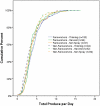The role of diet in children's exposure to organophosphate pesticides
- PMID: 26870919
- PMCID: PMC4821762
- DOI: 10.1016/j.envres.2016.02.003
The role of diet in children's exposure to organophosphate pesticides
Abstract
Background: Studies suggest that some of the greatest exposure to OPs in children occurs in agricultural communities and various pathways of exposure including the take-home pathway, proximity to orchards, and diet have been explored. However, the importance of the dietary pathway of exposure for children in agricultural communities is not well understood.
Objectives: Our goal was to ascertain whether there were associations between measures of OP exposure and apple juice, fruit, and vegetable consumption across growing seasons by children of farmworkers and non-farmworkers in a rural agricultural setting.
Methods: Study participants were children of farmworker (N=100) or non-farmworker (N=100) households from a longitudinal cohort study. Dietary intake of fruits and vegetables was assessed using a "5-A-Day" abbreviated food frequency questionnaire, and exposure to OPs was characterized using three urinary di-methyl and three di-ethyl metabolite measurements per child for each of three growing seasons. We used generalized estimating equations to examine data.
Results: Consumption frequency of fruits and vegetables was similar between children of farmworkers and non-farmworkers and across seasons. There were a few significant trends between dimethyl metabolites (DMAP) and fruit, vegetable or apple juice consumption; however, no clear pattern held across seasons or occupation. One difference was found in vegetable consumption during the harvest season, where the farmworker families showed a significant relationship between vegetable consumption and dimethyl metabolite levels (p=0.002). We also found a significant difference in this relationship between farmworkers and non-farmworkers (p=0.001). No significant trends between fruit and vegetable consumption and diethyl (DEAP) metabolites were found.
Conclusions: Our study shows the importance of considering season and parents' occupation in understanding OP exposure routes among children in an agricultural community. The impact of these factors on dietary OP exposure requires a more thorough analysis of the availability and consumption of produce from different sources including farms using pesticides where parents worked.
Keywords: Agricultural community; Children; Diet; Farmworker; Organophosphate pesticides; Pesticide; Pesticide exposure; Rural.
Copyright © 2016 Elsevier Inc. All rights reserved.
Figures



Similar articles
-
Characterization of organophosphate pesticides in urine and home environment dust in an agricultural community.Biomarkers. 2018 Mar;23(2):174-187. doi: 10.1080/1354750X.2017.1395080. Epub 2018 Jan 5. Biomarkers. 2018. PMID: 29047308 Free PMC article.
-
Seasonal and occupational trends of five organophosphate pesticides in house dust.J Expo Sci Environ Epidemiol. 2017 Jul;27(4):372-378. doi: 10.1038/jes.2016.45. Epub 2016 Aug 24. J Expo Sci Environ Epidemiol. 2017. PMID: 27553992
-
Seasonal variation in fruit and vegetable consumption in a rural agricultural community.J Am Diet Assoc. 2009 Jan;109(1):45-51. doi: 10.1016/j.jada.2008.10.007. J Am Diet Assoc. 2009. PMID: 19103322 Free PMC article.
-
Systematic Literature Review of the Take-Home Route of Pesticide Exposure via Biomonitoring and Environmental Monitoring.Int J Environ Res Public Health. 2019 Jun 19;16(12):2177. doi: 10.3390/ijerph16122177. Int J Environ Res Public Health. 2019. PMID: 31248217 Free PMC article.
-
Exposures of children to organophosphate pesticides and their potential adverse health effects.Environ Health Perspect. 1999 Jun;107 Suppl 3(Suppl 3):409-19. doi: 10.1289/ehp.99107s3409. Environ Health Perspect. 1999. PMID: 10346990 Free PMC article. Review.
Cited by
-
Organophosphate Insecticide Toxicity in Neural Development, Cognition, Behaviour and Degeneration: Insights from Zebrafish.J Dev Biol. 2022 Nov 21;10(4):49. doi: 10.3390/jdb10040049. J Dev Biol. 2022. PMID: 36412643 Free PMC article. Review.
-
Exposure Patterns of Multiple Pesticides and Urinary Alterations of Trimethylamine (TMA) and Trimethylamine N-Oxide (TMAO) among Pregnant Women.Environ Health (Wash). 2023 Dec 26;2(3):126-139. doi: 10.1021/envhealth.3c00124. eCollection 2024 Mar 15. Environ Health (Wash). 2023. PMID: 39473816 Free PMC article.
-
Pesticide Urinary Metabolites Among Latina Farmworkers and Nonfarmworkers in North Carolina.J Occup Environ Med. 2018 Jan;60(1):e63-e71. doi: 10.1097/JOM.0000000000001189. J Occup Environ Med. 2018. PMID: 29023343 Free PMC article.
-
Effects of Pesticide Intake on Gut Microbiota and Metabolites in Healthy Adults.Int J Environ Res Public Health. 2022 Dec 23;20(1):213. doi: 10.3390/ijerph20010213. Int J Environ Res Public Health. 2022. PMID: 36612532 Free PMC article.
-
Frequency of urinary pesticides in children: a scoping review.Front Public Health. 2023 Aug 29;11:1227337. doi: 10.3389/fpubh.2023.1227337. eCollection 2023. Front Public Health. 2023. PMID: 37711246 Free PMC article.
References
-
- Boon PE, Van der Voet H, Van Raaij MT, Van Klaveren JD. Cumulative risk assessment of the exposure to organophosphorus and carbamate insecticides in the Dutch diet. Food and chemical toxicology : an international journal published for the British Industrial Biological Research Association. 2008;46(9):3090–3098. - PubMed
Publication types
MeSH terms
Substances
Grants and funding
LinkOut - more resources
Full Text Sources
Other Literature Sources
Medical
Miscellaneous

